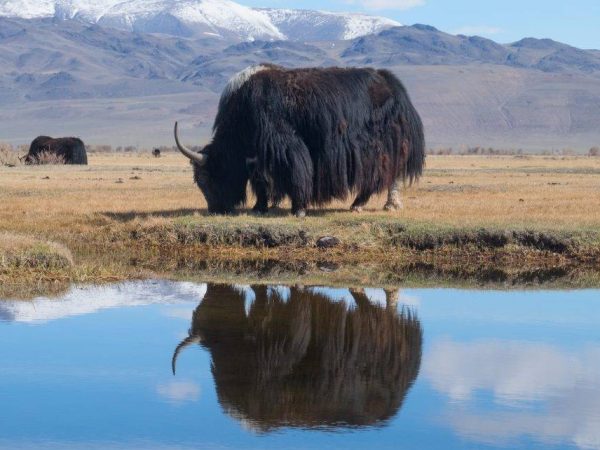Features of the animal yak
Once you see a yak in life or in a photograph, you are unlikely to confuse it with any other animal species, because this massive and incredibly memorable horned bull is a unique creature. The animal yak refers to artiodactyl mammals originating from the genus of real bulls.

Yak
The yak belongs to the bovine family, and Tibet is considered its homeland. It is exploited as a beef or pack animal, and some individual regions are even famous for the use of its milk. You can find out more about what kind of animals yaks are and what to expect from them below.
Short description
Yaks are solitary pack animals that can be found either in a small herd or in splendid isolation above sea level. Traditionally, the herd includes young females, to which the species under consideration can gradually join. The old male always lives separately. The maximum life span of an animal reaches several decades, due to its excellent resistance to adverse conditions and food shortages. To recognize this handsome man, you don't even need a picture, because the features of the animal are expressive and memorable.
- The yak is a very voluminous cattle (as any photo will prove), having a long body, despite short limbs. Its rounded hooves and low-set head stand out from other horned specimens.
- The height at the withers is often 2 m, while the mass reaches 1000 kg.
- The length of an already adult yak can be equal to 4.3 m, of which almost 1 meter is the tail of the animal. The female often does not exceed 3 m in length.
- The wild bull has a small hump which makes its back slightly sloping.
- The presence of long, medium-thick, widely spaced horns is another characteristic feature of these mammals. In the photo you can see how interesting they bend and go in different directions.
Features of the
The yak is an animal that is distinguished by its long hair that hangs from its body and completely covers the limbs - it is also shaggy. The color of the animal's coat is dark brown or grayish-black, but the muzzle is often decorated with white blotches.
The yak bull has reliable protection from the cold in the form of a thick matted undercoat - it falls out in the spring and summer. Sometimes in the photo you can see a team made from their wool. Another variant of wool forms a so-called "skirt" on the animal, which reaches the ground. This is the case when the predominant part of the body is covered with thick, even hair, and the limbs and belly are long and shaggy. The structure of the tail may resemble the tail of a horse; the hair on it is long and coarse. The source of energy, vitamins and nutrients for them is found in grass, mosses, lichens, and snow.
Home view - what is it
A creature like a yak can be both wild and domestic. The main difference is that the wild yak is dumb and the domestic yak is grunting. For external distinction, you need to look at the photos of both representatives. The domestic bull is different:
- smaller size and phlegmatic;
- rigidity;
- changeable color;
- strong susceptibility to disease.
The domestic bull yak is used as the main source of excellent milk and dairy products, which are sorely lacking in the highlands. Plus, the animals make excellent meat. The main distribution of domestic animals is in Central Asia, Tibet, Mongolia, Altai (where hainaks are used - cows mixed with a yak).
Many people think that a yak is a cow, but this opinion is incorrect. After crossing with a cow, a hainak is obtained, which is used as a draft animal, and it can be found only in Siberia. Khainakov distinguishes less stamina and smaller size, accompanied by a calm character.
What is known about the "savages"
From time immemorial, the wild bull was considered one of the most dangerous and evil animals. It is difficult to meet him now, because any places developed by a person are not suitable for his habitation. Now the wild bull is found only in the highlands of Tibet, to which it is perfectly adapted. Jacob is considered the most powerful, ferocious, evil animals that are capable of joining the fight at any moment and destroying any offender, be it a man or another wild animal.
Interestingly, even the attack of wolves on the animals in question does not occur alone. Most often it is a large flock, choosing a period of deep snow. It is not difficult to feel the danger for him, because he has an extremely acute sense of smell.
Finally
The description of wild bulls is a rather interesting and not fully explored topic, because, despite the ferocity and aggressiveness of animals, they are the most domesticated representatives of wildlife and are used to perform various agricultural tasks.
The rutting period occurs in early to mid-autumn, when the males begin to gradually join the females. At this time, males and females bring each other quite a lot of harm, because aggressive and bloody fights begin to occur between them, although the probability of death in such cases is almost 0. During the rut, you can often hear the deafening roar of the male, despite his silence at the usual time.
Despite the fact that it is very difficult for residents of the CIS countries and Russia to see a yak somewhere other than a photo, you need to remember about these species, because they are rapidly disappearing. Unfortunately, the number of yaks decreases every year due to the constant hunting.


